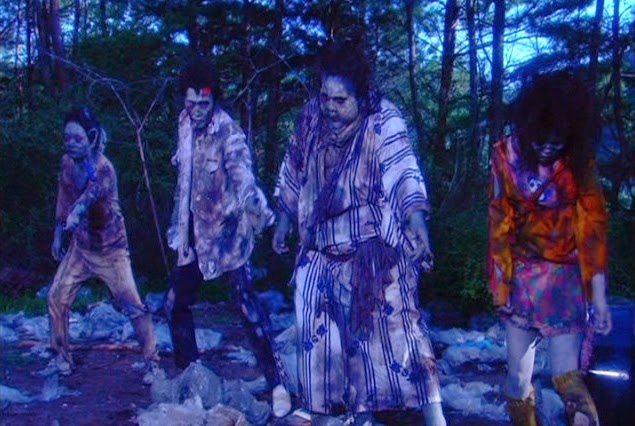Wolf Children (aka: Ookami Kodomo No Ame To Yuki) (2012) Director Mamoru Hosoda (Summer Wars, The Girl Who Leapt Through Time) brings us another winner, with
this beautifully animated, affecting tale. In Hosoda’s capable hands, bitter
and sweet come in equal doses, with the lighter moments balanced by tragic
interludes. College student Hana strikes up a doomed relationship with a
mysterious wolf man. Their two children, Yuki and Ame, possess properties of
both parents, resulting in some unexpected consequences. Hana takes her family
to the country to start a new life, far away from the prying eyes of the city.
In the ensuing years, she faces the prospect that her son and daughter are
steadily growing apart, and choosing separate paths. Parents will find much to
relate to in the allegorical aspects of this multi-layered story. Wolf Children
illustrates the sacrifices we make for our children, finding the strength to
let go when it’s time to make their own decisions.
Rating: **** ½. Available on Blu-ray and DVD.
The Face of Another
(1966) This meditation on identity and deception from director Hiroshi
Teshigahara and writer Kôbô Abe (based on his novel) explores the ramifications
of the literal and figurative masks people wear. After suffering an accident
that disfigured his face, businessman Okuyama (Tatsuya Nakadai) becomes cold
and embittered, distancing himself from his wife (Machiko Kyô) and co-workers.
He becomes the willing guinea pig for a psychiatrist’s (Mikijirô Hira) social
experiment, setting up a separate identity with his artificial face. The Face of Another illustrates how much
we are judged by our appearance. It also proves, to paraphrase the old adage,
you can fool some people some of the time, but others will always see through
our elaborate disguises. We may wear different masks, but they ultimately fail
to conceal the person within.
Rating: ****. Available on DVD and Hulu Streaming.
Love Exposure (aka: Ai No Mukidashi) (2008) Don’t let this
film’s four-hour running time deter you – it may be the quickest four hours
you’ll ever spend. Any synopsis would not do Love Exposure justice, which is comprised of three different
stories occurring simultaneously. After the death of his mother, Yû’s (Takahiro
Nishijima) father turns to the priesthood for solace. Clean cut Yû soon
discovers that the only way to get his father’s attention is through sinning.
As a result, he begins associating with a group of reprobates, and becomes a
master of upskirt photography (yeah, apparently it’s a thing in Japan). Meanwhile,
on the quest to find his true soulmate, and fulfill a promise to his mother, he
pursues the girl of his dreams, Yôko (Hikari Mitsushima). The only trouble is
she despises him. He’s also followed by members of a religious cult, the Zero
Church, led by the devious Koike (Sakura Andô). When Yû eventually tires of his
new hobby, he becomes a pervert priest of sorts, to absolve the sins of fellow
sexual deviants. Writer/director Shion Sono’s epic love story is a crazed,
mini-masterpiece, contrasting sacred and profane themes with equal skill. Do
yourself a favor, and set aside some time to watch this true original.
Rating: ****. Available on DVD.
The Rug Cop (aka: Zura Deka) (2006) Absurd comedy
specialist Minoru Kawasaki (Citizen
Koala, The Calamari Wrestler) returns with a parody of Japanese cop shows, and
leaves no stone unturned to skewer the usual clichés and stereotypes. Moto
Fuyuki plays our hero, Zura Deka (aka: Rug Cop ), a follicle-ly challenged
police detective with a checkered past who’s mastered the art of using his toupee
as a weapon. He’s accompanied by a rag-tag bunch, possessing singular...um…talents:
when sufficiently aroused, one cop wields his freakishly large member like a
lightsaber; another one has a wicked penchant for telling stale dad jokes;
while another charms women into submission with his rugged good looks. Kawasaki
keeps things fun throughout, including a karaoke sing-along, but never quite
tops the great opening scene where a ventriloquist’s dummy takes a bank hostage.
Recommended for those who prefer their silliness straight, with no chaser.
Rating: *** ½. Available on DVD
Godzilla vs.
Biollante (1989) For this entry in the Heisei series, the big G squares off
against a giant plant hybrid. A brilliant genetic researcher (Is there any
other kind in these flicks?) combines Godzilla’s DNA and his deceased daughter’s
essence, along with a rose, to create a new form of life. As anyone with a
pulse could imagine, it doesn’t turn out well. Maybe it was because of the bad
taste in my mouth from a recent viewing of the bloated 2014 American
re-imagining/reboot/whatever, but I had fun with this enjoyable, if
unremarkable entry in the series, replete with cartoonish human villains,
ineffective army weapons and monster mayhem. If nothing else, Biollante is
certainly one of the most unique foes the big reptile has faced to date.
Rating: ***. Available on Blu-ray
and DVD.
Tokyo Zombie (2005)
Tadanobu Asano and Shô Aikawa star as two losers, Fujio and Mitsuo, who bumble
through a zombie apocalypse. Prepare for many, many bald jokes at Mitsuo’s
expense (Yeah movie, we get it. He’s bald.),
contrasted by Fujio’s giant afro. Writer/director Sakichi Satô tries to strike
a balance between horror, broad humor and social satire but doesn’t really
succeed in any of these areas. The zombie makeup is mediocre at best, most of
the comic moments fall flat, and the film squanders opportunities for social
commentary. The story, based on a manga by Yûsaku Hanakuma, is divided into two
parts: the present day, and five years later, when zombies have more or less
taken over and the rich have set up fortress-like enclaves. It seems as if the
filmmakers were attempting something, but like its slacker protagonists, missed
the mark.
Rating: **. Available on DVD.






























